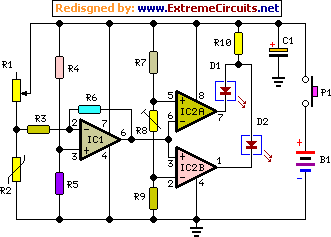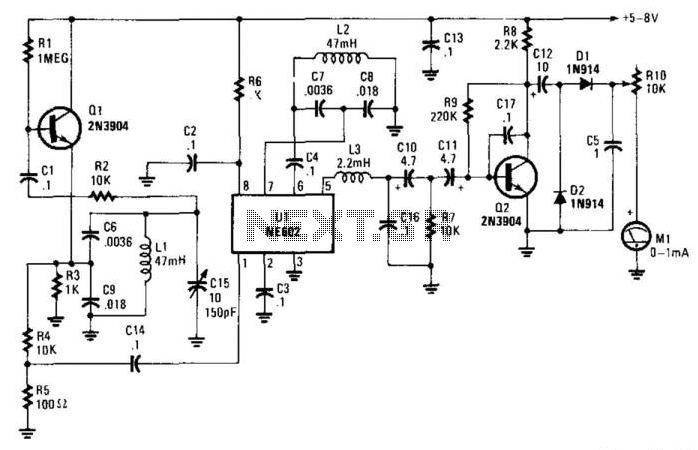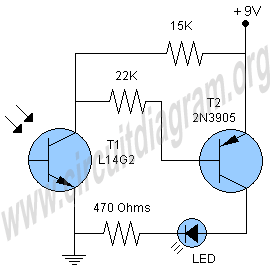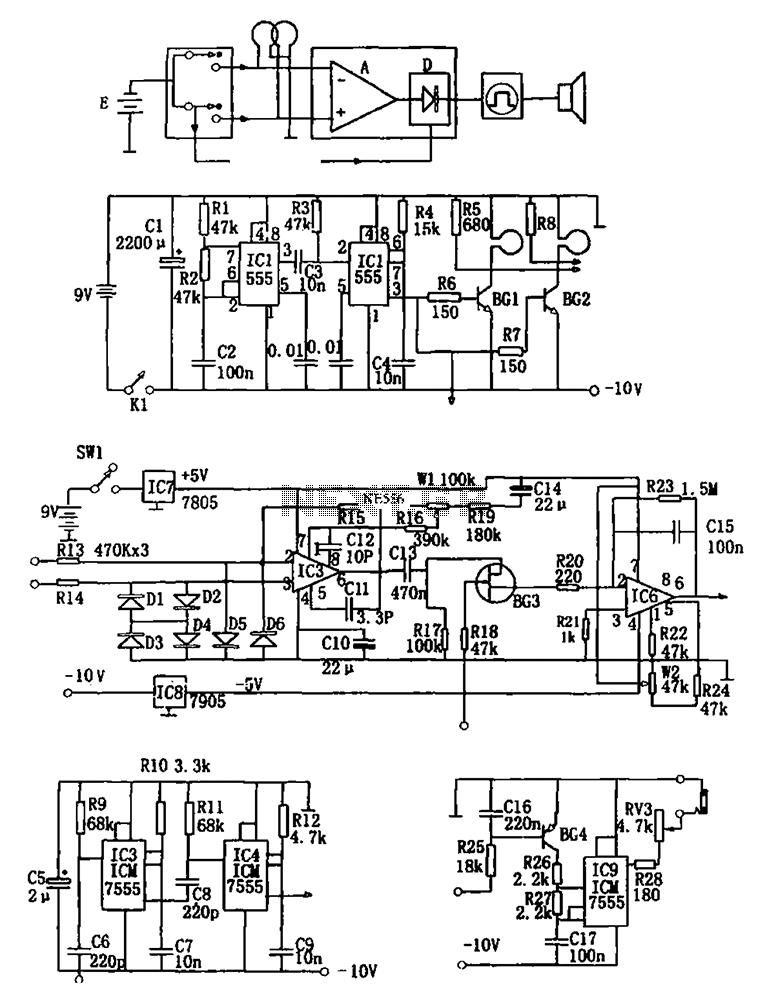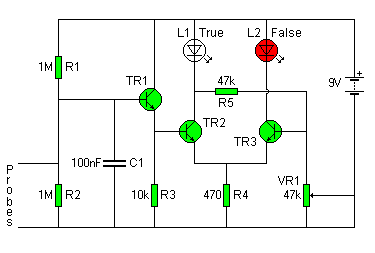
Small Metal Detector II
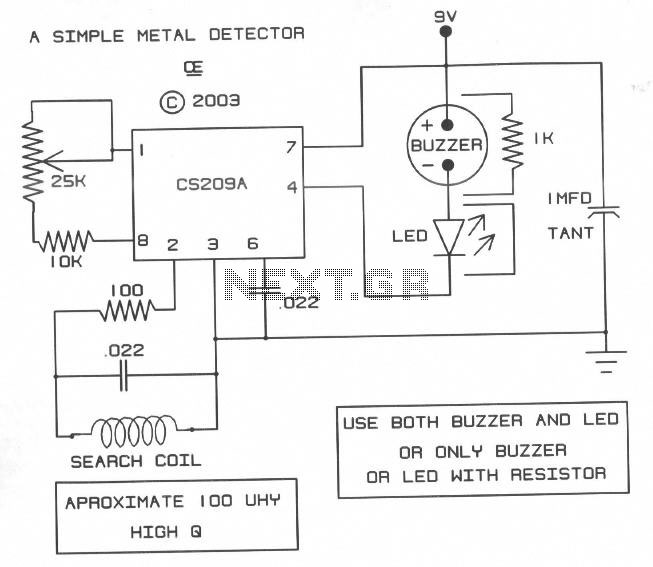
A simple design based on a CS209A IC that can give surprising results and draws very little current from a 9-volt battery. It worked well on the bench but not so good outside for general metal detecting. However, it is definitely a good design for detecting studs in a wall, with the right coil. This particular circuit was built so it can be used with an LED and buzzer, or just the LED, or just the buzzer. Battery voltage can be up to 20 volts, but it doesn't add to the sensitivity. In addition, changes to the potentiometer value can be made, adding a smaller pot in series to make a more sensitive trip point. This circuit operates on the principle of changes in "Q" of the coil. Therefore, it is important to try and make a high Q coil. However, even simple coils gave fairly good results. It is recommended to use "Litz" wire, but vinyl covered wire and magnet wire also yield good results. After assembling a board and conducting a few tests outside, it appears the coil needs a Faraday shield. Unfortunately, Litz wire is hard to find, but it does help. Additionally, a coil wound on a "Power Ferrite Rod" can provide good sensitivity as well as an accurate pinpointing effect of metal objects. Free samples of the chip were obtained from "On Semiconductor", but most users will need to purchase it. Etched and drilled PCBs are available for $3.00 each, plus a postage cost of $1.00. However, this is not suitable for the surface mount package. The CS209 is no longer supplied, but it is available from some sources, although only in the surface mount package and with a minimum order of 100 pieces.
The described circuit utilizes the CS209A integrated circuit, which is designed for low-power applications, making it suitable for battery-operated devices such as metal detectors. The circuit operates primarily on the principle of detecting changes in the quality factor (Q) of a coil, which is crucial for achieving sensitivity in metal detection applications.
To optimize performance, the circuit can be configured to work with either an LED indicator, a buzzer, or both, providing flexibility in user feedback. The choice of a 9-volt battery as the power source contributes to the low current draw, enhancing battery life. The circuit can accommodate input voltages up to 20 volts, although increasing the voltage does not improve sensitivity. Adjustments can be made to the sensitivity of the circuit by varying the potentiometer values, allowing for fine-tuning based on user requirements.
The design emphasizes the importance of the coil’s Q factor, which can be enhanced by using high-quality materials. While Litz wire is recommended for its superior performance, alternative wire types such as vinyl-covered wire or magnet wire have also been found to yield satisfactory results. The inclusion of a Faraday shield is suggested to mitigate interference and improve the overall performance of the coil in outdoor environments.
For optimal sensitivity and pinpoint accuracy, the use of a coil wound on a power ferrite rod is recommended. This configuration can significantly enhance the detection capabilities of the circuit, allowing for precise location identification of metal objects.
The availability of the CS209A IC may be limited, with the surface mount package being the only option for purchase from certain suppliers, requiring a minimum order quantity. For those interested in building the circuit, pre-manufactured PCBs are accessible, which simplifies the assembly process. However, these boards are not compatible with surface mount components, thereby limiting the design options for users who prefer this packaging type.A Simple design based on a CS209A IC that can give surprising results and draws very little current from a 9 volt battery. It worked good on the Bench, But not so good outside for general metal detecting. But Definately a good design for detecting studs in a wall, with the right coil! This particular circuit was built so it can be used with an LED and Buzzer or just the LED or just the Buzzer.
Battery voltage can be up to 20 volts, but it doesn't add to the sensitivity. In Addition, Changes to the Potentiometer value can be made, adding a smaller pot in series to make a more sensitive trip point. This circuit operates on the principal of changes in "Q" of the coil. So it is important to try and make a High Q coil! But I found that even simple coils gave fairly good results! It is recommended to use "Litz" Wire, But I just used vinal covered wire on one and also another with magnet wire and I got pretty good results with both coils. Having now put a board together and a few tests outside, it appears the coil needs a Faraday Shield.
Unfortunately, Litz Wire is hard to find, but it does help! Additionally a coil wound on a "Power Ferrite Rod" can give good sensitivity as well as abn Accurate Pin-pointing effect of metal objects! I obtained Free Samples of the chip from "On Semiconductor", but unfortunately most of you will have to buy it.
Etched and drilled PCB's are available for $3.00 ea. US Funds, Plus a Postage cost of $1.00. But this is NOT SUITABLE for the Surface Mount Package. I can No Longer Supply the CS209 It is available from Some Sources, But only in the Surface Mount Package, And with a Minimum Order of 100 Pieces. 🔗 External reference
The described circuit utilizes the CS209A integrated circuit, which is designed for low-power applications, making it suitable for battery-operated devices such as metal detectors. The circuit operates primarily on the principle of detecting changes in the quality factor (Q) of a coil, which is crucial for achieving sensitivity in metal detection applications.
To optimize performance, the circuit can be configured to work with either an LED indicator, a buzzer, or both, providing flexibility in user feedback. The choice of a 9-volt battery as the power source contributes to the low current draw, enhancing battery life. The circuit can accommodate input voltages up to 20 volts, although increasing the voltage does not improve sensitivity. Adjustments can be made to the sensitivity of the circuit by varying the potentiometer values, allowing for fine-tuning based on user requirements.
The design emphasizes the importance of the coil’s Q factor, which can be enhanced by using high-quality materials. While Litz wire is recommended for its superior performance, alternative wire types such as vinyl-covered wire or magnet wire have also been found to yield satisfactory results. The inclusion of a Faraday shield is suggested to mitigate interference and improve the overall performance of the coil in outdoor environments.
For optimal sensitivity and pinpoint accuracy, the use of a coil wound on a power ferrite rod is recommended. This configuration can significantly enhance the detection capabilities of the circuit, allowing for precise location identification of metal objects.
The availability of the CS209A IC may be limited, with the surface mount package being the only option for purchase from certain suppliers, requiring a minimum order quantity. For those interested in building the circuit, pre-manufactured PCBs are accessible, which simplifies the assembly process. However, these boards are not compatible with surface mount components, thereby limiting the design options for users who prefer this packaging type.A Simple design based on a CS209A IC that can give surprising results and draws very little current from a 9 volt battery. It worked good on the Bench, But not so good outside for general metal detecting. But Definately a good design for detecting studs in a wall, with the right coil! This particular circuit was built so it can be used with an LED and Buzzer or just the LED or just the Buzzer.
Battery voltage can be up to 20 volts, but it doesn't add to the sensitivity. In Addition, Changes to the Potentiometer value can be made, adding a smaller pot in series to make a more sensitive trip point. This circuit operates on the principal of changes in "Q" of the coil. So it is important to try and make a High Q coil! But I found that even simple coils gave fairly good results! It is recommended to use "Litz" Wire, But I just used vinal covered wire on one and also another with magnet wire and I got pretty good results with both coils. Having now put a board together and a few tests outside, it appears the coil needs a Faraday Shield.
Unfortunately, Litz Wire is hard to find, but it does help! Additionally a coil wound on a "Power Ferrite Rod" can give good sensitivity as well as abn Accurate Pin-pointing effect of metal objects! I obtained Free Samples of the chip from "On Semiconductor", but unfortunately most of you will have to buy it.
Etched and drilled PCB's are available for $3.00 ea. US Funds, Plus a Postage cost of $1.00. But this is NOT SUITABLE for the Surface Mount Package. I can No Longer Supply the CS209 It is available from Some Sources, But only in the Surface Mount Package, And with a Minimum Order of 100 Pieces. 🔗 External reference
